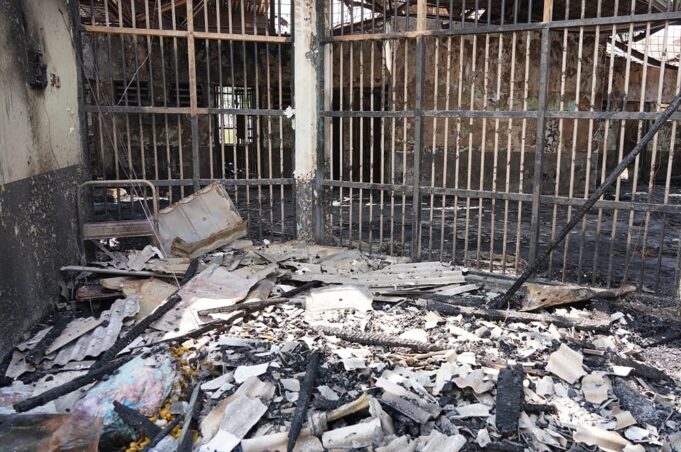JAKARTA, Indonesia—A massive fire raged through an overcrowded prison near Indonesia’s capital early Sept. 8, killing at least 41 inmates, two of them foreigners serving drug sentences, and injuring 80 others.
Firefighters battled through the early morning hours to extinguish the flames as black smoke billowed from the compound of the Tangerang prison on the outskirts of Jakarta.
After the blaze was extinguished, ambulance after ambulance filled with body bags containing the victims were driven by Red Cross workers to the morgue of a local hospital, where they were stacked wall-to-wall on the floor of a room awaiting transport to a larger facility for identification.
Relatives of prisoners trickled into the prison throughout the day to check and see whether their loved ones were among those killed.
Most of the 41 killed were drug convicts, including a man from South Africa and a man from Portugal, while other victims included a terrorism convict and a murderer, Indonesia’s Law and Human Rights minister Yasona Laoly told reporters.
He expressed his deep condolences for the families of the victims and pledged to provide the best treatment for those injured.
“This is a tragedy that concerns all of us,” Mr. Laoly said. “We are working closely with all relevant parties to investigate the causes of the fire.”
The fire broke out at 1:45 a.m. in Block C2 of the prison, where the 19 cells that were built to hold 40 inmates were stuffed full with more than triple that number. The cause of the blaze appears to have been an electrical short circuit, according to initial findings, Jakarta Police Chief Fadil Imran said.
As the fire was brought under control, hundreds of police and soldiers were deployed around the prison to prevent prisoners from escaping, Imran told reporters near the scene.
Problems are rampant in Indonesia’s prisons, largely due to overcrowding. More than half of the system’s inmates are being held on narcotics offenses, a product of the country’s war on drugs.
As of July, there were a total of 268,610 inmates in Indonesia’s prisons, which were built to hold 132,107 people.
Tangerang prison, located in the heart of Tangerang city in Jakarta’s neighboring province of Banten, was designed to house 900 inmates but has more than 2,000, Mr. Laoly said. Officials had earlier said it was built to accommodate 1,225 inmates.
The government has acknowledged the problem and is planning to refocus its approach toward drug offenders to start looking at them as addicts who need treatment, rather than criminals, in the hope of dramatically reducing the number incarcerated.
Reynhard Silitonga, the head of corrections at the Ministry of Law and Human Rights, told The Associated Press in an e-mail that if there isn’t a change in policy, the number of inmates could top 400,000 within five years.
With the new approach, “the spirit of handling drug offenders, especially users, is directed at the health aspect, no longer imprisonment,” he said.
He did not say how long it would take to implement the changes.
In addition to those who died in the Tangerang fire, eight inmates were hospitalized with severe burns and nine with light injuries were treated at a prison clinic, the Ministry of Law and Human Rights said. Another 64, many suffering smoke inhalation, were evacuated to a mosque in the compound for observation.
The 15 corrections officers guarding the cell block were unhurt, said Rika Aprianti, spokesperson for the corrections department.
Agus Toyib, who heads the Banten provincial law and human rights office, which oversees Tangerang, said understaffing at the prison led to delays in rescuing inmates from their locked cells.
“Most victims caught fire as they didn’t have enough time to get out of their cells and the fire was growing rapidly,” he said. (AP)













